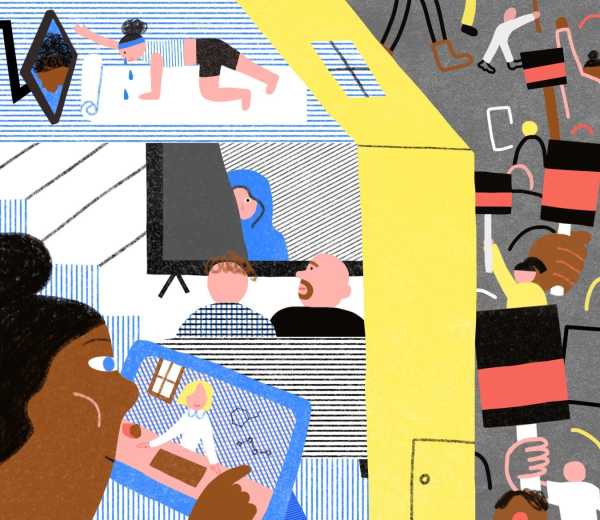
Save this storySave this storySave this storySave this story

Shauna Lyon
Goings On editor
You’re reading the Goings On newsletter, a guide to what we’re watching, listening to, and doing this week. Sign up to receive it in your in-box.
For the first time since 2019, the fall culture calendar, especially for live events, is in full swing. The actors’ and writers’ strikes—with no end yet in sight—will likely continue to have ripple effects on the season’s television and movie slates, but there is still plenty to see, hear, and do in New York City and beyond. Here, in our fall culture previews, our critics round up the most exciting events on the horizon. At the theatre, I’m looking forward to plays by the vital contemporary playwrights Branden Jacobs-Jenkins and Annie Baker, as well as Rachel Bloom’s COVID-era musical, “Death, Let Me Do My Show,” and Josh Gad and Andrew Rannells’s “Gutenberg! The Musical!”—their first Broadway reunion since their smash pairing in “The Book of Mormon,” twelve years ago. The city’s music venues are stacked with shows from Janelle Monae, boygenius, the Wu-Tang Clan, Nas, and Stevie Nicks, to name but a few. Lincoln Center hosts three Metropolitan Opera House premières, as well as the return of full seasons for both New York City Ballet and American Ballet Theatre; blockbuster museum exhibitions of Manet and Degas (at the Met) and Ed Ruscha (at MOMA) will hold their own alongside showcases of the relatively lesser-known painters Barkley L. Hendricks (at the Frick) and Henry Taylor (at the Whitney). And the stars are blazing at the movies: DiCaprio, Chalamet, and Cumberbatch lead, respectively, Martin Scorsese’s “Killers of the Flower Moon,” a “Dune” sequel, and Wes Anderson’s adaptation of Roald Dahl’s “The Wonderful Story of Henry Sugar.” We’ll see you there.
Jump to: Television | Theatre | Contemporary Music | Classical Music | Dance | Art | Movies
Television

Illustration by Jam DongStrikes, Game Shows, Novel Adaptations
This fall television season is—to put it mildly—a weird one. The SAG-AFTRA and W.G.A. strikes have stretched on through the summer, turning Hollywood into a tense battleground for the very future of the television industry. The questions are both practical (how can the broken residuals system be fixed in the age of streaming?) and existential (how can writers and actors insure that A.I. doesn’t put them out of work and degrade the quality of entertainment for generations to come?). The studios and streamers and the W.G.A. are finally meeting about a new contract, but, as of now, there will be no fresh late-night shows, no new “S.N.L.,” and few scripted network débuts. The prime-time network schedule is thick with singing competitions, cooking battles, and game shows that sound like punch lines from “30 Rock”—if I told you that Fox has a new game show called “Snake Oil,” in which contestants pitch fake products to David Spade while he wears an old-timey boater hat, would you believe me? Well, it’s coming, on Sept. 27.
Although the streamers did manage to bank some shows before work stoppages went into effect, many have opted to push their premières until later in the fall, when (they hope) the strike will be over and star talent will be allowed to promote their work. The actress and writer Brit Marling and her showrunning partner, Zal Batmanglij, the creators of the delectably weird (and gone too soon) Netflix drama “The OA,” were supposed to début their new FX show, “A Murder at the End of the World,” on Hulu on Aug. 29, but the release date has been moved to Nov. 14. This makes sense—the show, which stars Emma Corrin as a Lisbeth Salander-esque computer hacker who must solve a murder case while holed up at the remote compound of a tech billionaire (Clive Owen), is the kind of twisty mystery with big names attached which has the potential to be a major hit if given the right push.
Still, several shows are proceeding as planned, including three notable offerings based on best-selling novels. On Sept. 13, Hulu débuts “The Other Black Girl,” adapted from Zakiya Dalila Harris’s thriller about a Black woman who befriends the one other Black woman working at her publishing house only to discover that something truly sinister is happening at the office. On Oct. 13, Apple TV+ airs “Lessons in Chemistry” (based on the book by Bonnie Garmus), which stars Brie Larson as an ambitious nineteen-fifties television personality who uses her cooking show to teach housewives about science. On Nov. 2, Netflix débuts “All the Light We Cannot See” (adapted from the book by Anthony Doerr), which follows a blind teen-ager and her father as they flee Occupied Paris during the Second World War. Also in November, Amazon Prime airs the much anticipated “Mr. & Mrs. Smith” remake, starring Donald Glover and Maya Erskine as a pair of married assassins.
There will also be, of course, a flood of home-makeover shows and international imports, villa-based dating competitions and sports documentaries—the compelling Netflix series “Untold” is back with new installments about the Florida Gators and Jake Paul’s boxing career—to fill the scant television cupboards this season, but if you find yourself flipping around aimlessly you won’t be alone. The vibes, as they say, are off.—Rachel Syme
The Theatre

Illustration by Jam DongBarn-Burner Sondheim, Irish Drama, Antic Musicals
Sharpen your pencils and grab your backpacks: autumn in New York is back-to-theatre season. With the city as your campus, there’s a certain scholastic crispness to this fall’s programming. For example, the barn-burner revival of Stephen Sondheim’s “Merrily We Roll Along,” from 1981, transfers to the Hudson Theatre on Sept. 19—with Jonathan Groff, Lindsay Mendez, and Daniel Radcliffe—in the same month that Sondheim’s Luis Buñuel-inspired, last-ever musical, “Here We Are,” gets a blockbuster, all-star cast (Amber Gray! David Hyde Pierce!) for its posthumous première at the Shed (starting previews on Sept. 28). If you see them both, you’re basically taking an informal seminar in Sondheimian aesthetics.
There’s enough this season, too, for a (self-administered) degree in Irish drama. You could start by studying Seán O’Casey, the socialist giant: Druid Theatre’s “DruidO’Casey” (N.Y.U. Skirball; Oct. 4-14) brings his entire Dublin Trilogy from the nineteen-twenties—“The Plough and the Stars,” “The Shadow of a Gunman,” and “Juno and the Paycock”—in the season’s most exciting international visit. Follow that up at our own Irish Repertory Theatre, which stages Brian Friel’s masterpiece “Translations” (Oct. 20) as part of its encyclopedic Friel Project, and finish with a class in contemporary Irish bardic storytelling: Mikel Murfi’s trilogy of solo plays, at the Irish Arts Center (Oct. 24).
The city also seems to be conducting a survey course in important contemporary American playwrights: the Pulitzer Prize winner Annie Baker’s “Infinite Life” (Atlantic Theatre Company; opening on Sept. 12) is one of the season’s most anticipated premières, and Branden Jacobs-Jenkins, a two-time Pulitzer Prize finalist, comes, finally, to Broadway, with his barbed family thriller “Appropriate” (Hayes; Nov. 28). Other names on that fantasy curriculum include Jocelyn Bioh, whose comedy “Jaja’s African Hair Braiding” is at the Samuel J. Friedman (Sept. 12); David Adjmi, whose rock-band drama, “Stereophonic,” débuts at Playwrights Horizons (Oct. 6); Qui Nguyen, offering his autofictional “Poor Yella Rednecks” at New York City Center (Oct. 10); and Hansol Jung, who re-genders and re-queers Restoration comedy in “Merry Me,” at New York Theatre Workshop (Oct. 11).
The majority of the new Broadway offerings are humorous or musical approaches to profound subjects: Ossie Davis’s comedy “Purlie Victorious” (Music Box; Sept. 7), from 1961, revolves around a preacher outwitting a racist Southerner; Barry Manilow and Bruce Sussman’s musical “Harmony” (Ethel Barrymore; Oct. 18) remembers a forgotten German sextet torn apart by the Second World War; the new musical “How to Dance in Ohio” (Belasco; Nov. 15) is based on Alexandra Shiva’s documentary about autistic young adults getting ready for their first spring formal; and Theresa Rebeck’s “I Need That” (American Airlines Theatre; Oct. 13) wrings jokes out of hoarding and eviction. There will be much for the class to discuss.
But any schoolroom needs goofballs in the back throwing chalk—which leads us to the antic Rachel Bloom’s one-woman COVID musical, “Death, Let Me Do My Show” (Lucille Lortel; Sept. 6). The season’s other class clowns are “Gutenberg! The Musical!” (James Earl Jones; Sept. 15), in which the buddy act of Josh Gad and Andrew Rannells play musical-comedy writers trying to impress potential backers, and “Spamalot” (St. James; Oct. 31), the nutty Eric Idle musical from 2005, taking another swing at Broadway. Speaking frankly, though, Theatre for a New Audience’s production of Samuel Beckett’s “Waiting for Godot” (Nov. 4) just might be the zaniest of all. I once saw its stars, Michael Shannon and Paul Sparks, crack each other up onstage so hard that they had to hide under a blanket. If you think a little existential dread will make them behave, I’ve got a tree and a moon to sell you.—Helen Shaw
Contemporary Music

Illustration by Jam DongAfro-Pop, R. & B. Greats, Hip-Hop Diversity
As a summer full of mellow outdoor concerts comes to a close, the fall makes way for multiplicity. It’s a seasonal slate defined by its sprawl, with several exciting and eclectic one-off events and young stars rising to newfound status at the arena level.
Pop music comes in all stripes, and from across nations. Afro-pop continues its Stateside expansion with Ayra Starr (Webster Hall; Sept. 2) and Asake (Barclays Center; Sept. 8). The slick K-pop girl groups aespa and LOONA hit Barclays (Sept. 5) and the Theatre at Madison Square Garden (Sept. 15), respectively. At MetLife, the Colombian singer Karol G experiments with Latin trap and reggaetón (Sept. 7-8). Dynamic artists tinker in three shows at Terminal 5: Róisín Murphy embraces the minimal techno of DJ Koze (Sept. 27), Jessie Ware reinvigorates disco and funk (Oct. 20-21), and Tinashe and Shygirl test out glitchy, club-aligned bops (Nov. 1).
Some R. & B. greats make New York stops on tours supporting their latest albums: Janelle Monáe luxuriates in “The Age of Pleasure” at Radio City Music Hall (Sept. 26); SZA christens the long-awaited, chart-conquering “SOS” at Barclays (Oct. 6-7); and the charismatic piano man John Legend tells stories and performs songs from “Legend” at the Beacon Theatre (Nov. 7-8).
As hip-hop celebrates its fiftieth anniversary, a string of shows commemorate the genre’s diversity. In a performance at Barclays, the droner Gunna runs through the solemn post-RICO songs of “a Gift & a Curse” (Sept. 9). Backed by a live band, the polymath Denzel Curry reveals jazzy renditions from his album “Melt My Eyez See Your Future” at the Blue Note (Sept. 12-13). The jazz-rap pioneer Ishmael Butler and his group Shabazz Palaces continue their explorations into cosmic rap at Bowery Ballroom (Oct. 3). In a few dates at Terminal 5, the punchy duo Run the Jewels (Sept. 13-16) and the casual English bard Little Simz (Oct. 13) each display their dynamic lyricism.
A co-billed show of local hip-hop titans—the Wu-Tang Clan and Nas at Barclays Center, on Sept. 27—kicks off a series of performances featuring twentieth-century stars basking in their longevity. Slowdive, trailblazers of nineties shoegaze, celebrate a new album with a pair of gigs at Webster Hall (Sept. 27-28), and the pop-rock icon Stevie Nicks, an integral member of Fleetwood Mac, brings the full force of her singular voice to M.S.G. on Oct. 1.
The very next day, at the same venue, members of a new generation of talented indie-rock singer-songwriters—Julien Baker, Phoebe Bridgers, and Lucy Dacus—perform together in the supergroup boygenius. The folk musician Julie Byrne moves hopefully through loss during her Bowery Ballroom set (Sept. 21) with enchanting music that honors her late collaborator Eric Littmann. At Radio City Music Hall, the singer and guitarist Michelle Zauner works toward joy as Japanese Breakfast (Oct. 5). The reunited pop-punk band Paramore samples the skipping music of its latest album, “This Is Why,” at Webster Hall (Oct. 6), and, at Music Hall of Williamsburg, the folk-adjacent soloists Miya Folick (Oct. 5) and S. G. Goodman (Nov. 3) sing delightful songs in which traumatized characters turn their lives inside out.
For something a bit more left of center, look to instrumentalists in disparate fields. Electronic music is well represented by artists of opposing spheres: the fast-rising producer and d.j. Fred Again, who plays Forest Hills Stadium (Oct. 12-14), and the minimalist noise veteran Tim Hecker, at Pioneer Works (Nov. 10). Meanwhile, two harpists at different ends of the string spectrum—the experimental Mary Lattimore (Union Pool; Nov. 3) and the jazz revivalist Brandee Younger (Kupferberg Center for the Arts; Nov. 11)—bring vibrant new life to the form.—Sheldon Pearce
Classical Music

Illustration by Jam DongMet Premières, Jaap van Zweden’s Finale
The Metropolitan Opera triples down on contemporary music and its ability to tell modern-day stories with three company premières—Jake Heggie’s “Dead Man Walking” (Sept. 26-Oct. 21), Anthony Davis’s “X: The Life and Times of Malcolm X” (Nov. 3-Dec. 2), and Daniel Catán’s “Florencia en el Amazonas” (Nov. 16-Dec. 14).
Les Arts Florissants sticks to sumptuous realizations of Baroque gems with Purcell’s frolicsome semi-opera “The Fairy Queen,” at Alice Tully Hall (Nov. 2). Kate Soper’s new chamber opera, “The Hunt,” at Miller Theatre (Oct. 12 and Oct. 14), also deals with forest enchantments: three virgin maids live-stream their experience of being used as bait for a unicorn hunt. At Park Avenue Armory, Jonas Kaufmann conjoins his theatrical flair and his love of lieder in “Doppelganger,” a staging of Schubert’s cycle “Schwanengesang” (Sept. 22-28).
For Jaap van Zweden’s final season at the helm of the New York Philharmonic, the conductor surrounds himself with such luminaries as Yo-Yo Ma, in Dvořák’s Cello Concerto (Sept. 27); the violinist Joshua Bell, in “The Elements,” a piece crowdsourced from five major composers (Sept. 29-Oct. 1); and the minimalist legend Steve Reich, whose “Jacob’s Ladder” has its world première (Oct. 5-7).
The redoubtable Riccardo Muti opens Carnegie Hall’s season with the Chicago Symphony Orchestra and Leonidas Kavakos in Tchaikovsky’s lovely Violin Concerto (Oct. 4). Also at Carnegie, Isata Kanneh-Mason (Oct. 17), Alexandre Kantorow (Oct. 22), and Lea Michele (Oct. 30) make solo débuts, and the Kronos Quartet celebrates its fiftieth anniversary (Nov. 3). Just shy of its own half-century mark, the Emerson String Quartet bids farewell to the stage, at Alice Tully Hall (Oct. 21-22), with Schubert’s final chamber work, the Quintet in C Major—an exquisite valediction.—Oussama Zahr
Dance

Illustration by Jam DongAll-Male Hula, a Tennis Ballet
Outdoor dance is nice, but there’s nothing like being in a theatre, with its dramatic lighting and proscenium. At New York City Center’s popular and populist Fall for Dance Festival (Sept. 27-Oct. 8), twenty dollars buys an evening that might include the all-male hula troupe Kaleoolakaikahikinaokalā evoking Hawaii’s traditions through song, drumming, and movement (Oct. 3-4), or the ecstatic dancing of Brazil’s Grupo Corpo (Oct. 7-8).
New York’s two resident ballet companies take turns at Lincoln Center’s David H. Koch Theatre. First comes New York City Ballet’s seventy-fifth-anniversary season (Sept. 19-Oct. 15), devoted to the works of its founding choreographer, George Balanchine. The lineup includes a program (on Oct. 11) that replicates the company’s opening night, in 1948: the spare “Concerto Barocco”; “Orpheus,” Balanchine’s poetic take on the Greek myth; and the joyful “Symphony in C.”
American Ballet Theatre’s first New York season planned entirely by its incoming director, Susan Jaffe (Oct. 18-29), includes several one-act ballets, from Harald Lander’s “Études,” a celebration of ballet technique, to Alonzo King’s tensile “Single Eye.” Most resonantly, A.B.T. brings back Alexei Ratmansky’s “On the Dnipro,” about a Ukrainian soldier returning to his village after the First World War.
Christopher Williams reimagines Nijinsky’s lost 1913 ballet, “Jeux” (Baryshnikov Arts Center; Oct. 12-15), an exploration of the ambiguities of sexual attraction through the prism of a tennis match. And Van Cleef & Arpels brings a new festival, Dance Reflections, to the city (Oct. 19-Dec. 14). Among other offerings, Lyon Opera Ballet performs Lucinda Childs’s minimalist classic “Dance” (New York City Center; Oct. 19-21), and the Polish French dance artist Ola Maciejewska presents her tribute to the illusionism of Loïe Fuller (French Institute Alliance Française; Nov. 2-3).—Marina Harss
Art

Illustration by Jam DongManet and Degas, Ruth Asawa, Ed Ruscha
“Barkley L. Hendricks: Portraits at the Frick” (opening on Sept. 21) marks a homecoming of sorts for Hendricks, who died in 2017, at the age of seventy-two. The exhibition places fourteen of his paintings, made between the late nineteen-sixties and the early eighties, under the same roof as the Old Masters to which Hendricks, their dedicated student, returned throughout his life. Like all the greatest portraitists, Hendricks rendered glimmers of his subjects’ interior lives via the particularities of their personal style, the poses they strike, and the precise wattage of their skin’s radiance, remaining steadfastly devoted to, in his words, “the beauty and variety of complexion colors that we call Black.”
A fateful first meeting of Édouard Manet (1832-83) and Edgar Degas (1834-1917) at the Louvre, in the early eighteen-sixties, led to a two-decade conversation—at times friendly, at other times charged by a less than collegial frisson—as each pursued his own audacious, masterly hand. “Manet/Degas,” at the Met (Sept. 24), brings together a hundred and sixty paintings and works on paper by these disparate titans, whose art became part of the radical terra firma in which modernism took root. Especially delectable among the exhibition’s many delights: Degas’s portrait of Manet and his wife, which rankled Manet so much that he sliced its canvas, and Manet’s succès de scandale “Olympia,” here in her American début.
The Whitney exhibition “Ruth Asawa Through Line” (Sept. 16) honors the artist’s daily drawing practice, highlighting the contemplations on paper of shape, light, and shadow—many made public here for the first time—which informed her airy and voluptuous wire sculptures. Also at the Whitney is “Henry Taylor: B Side” (Oct. 4), the first survey of the artist’s career over the past thirty-plus years, during which he has become best known for paintings that level our attention across celebrities, politicians, family, and friends alongside the incarcerated, the institutionalized, and the terrorized. “Support the Black Panthers” reads a banner hanging over one disquieting installation, comprising dozens of mannequins gathered around a podium and dressed in black leather jackets—all headless, yet somehow still self-possessed.
Indeterminacy, ephemerality, fluidity—these were some of the guiding principles of the Fluxus movement, which held that every moment of life had the potential to become, or to deliver, a work of art. Japan Society’s “Out of Bounds: Japanese Women Artists in Fluxus” (Oct. 13) showcases four of its under-sung genre-benders—Shigeko Kubota, Yoko Ono, Takako Saito, and Mieko Shiomi—who prove that what slips through the system often sticks to the spirit with greater force. The exhibition spotlights some of their pathbreaking performances, such as Ono’s “Cut Piece,” from 1964, for which audience members were invited to disrobe the artist one scissor snip at a time, and Kubota’s “Vagina Painting,” from 1965, which upended (so to speak) Abstract Expressionism’s long-crowing machismo.
Oklahoma City-raised and Los Angeles-chilled, Ed Ruscha belongs to a generation of men for whom the Wild West gave way to a liberated libido, driven to consume anything and everything in sight, casting the artist as both America’s keenest critic and its No. 1 fan. Sixty-five years of his prodigious output is presented in “Ed Ruscha / Now Then,” at MOMA (Sept. 10-Jan. 13), a sprawling exhibition conceived to seal his reputation as one of our canniest image-makers and a master of many media. Arcing from his initial revelations sparked by Pop’s sonorous vernacular—behold “OOF,” “SPAM,” and “HONK” writ large—to a more recent painting of a shredded American flag, still waving in the cataclysmic winds of change, his is an epic tale that continues to unfold.—Jennifer Krasinski
Movies

Illustration by Jam DongReal-Life Drama, New Fantasies
Though studios’ fall schedules have been shifting because of the actors’ union’s ongoing strike, which bars members from making promotional appearances, the release calendar is nonetheless crowded. Dramas based on real-life stories are among the season’s most prominent offerings, including “Killers of the Flower Moon” (opening on Oct. 6), directed by Martin Scorsese and based on a book by David Grann, of The New Yorker. The film is centered on the discovery of oil by members of the Osage Nation, in Oklahoma, and the murder of Osage people, in the nineteen-twenties, by white Oklahomans who sought to control the resulting wealth. Leonardo DiCaprio, Robert De Niro, Lily Gladstone, and Tantoo Cardinal star. “Priscilla” (Oct. 27), directed by Sofia Coppola, is a bio-pic about Priscilla Presley, based on her autobiography and starring Cailee Spaeny in the title role and Jacob Elordi as Elvis. “Cassandro” (Sept. 15) is a biographical drama about Saúl Armendáriz, who was one of Mexico’s first openly gay wrestlers (he was the subject of the 2018 documentary “Cassandro, the Exotico!”); Gael García Bernal stars, and Roger Ross Williams directed. The social-media-fuelled buying frenzy for GameStop stock, in January, 2021, which resulted in a Wall Street crisis, is fictionalized in “Dumb Money” (Sept. 15), directed by Craig Gillespie and starring Paul Dano, Shailene Woodley, America Ferrera, and Seth Rogen.
Fantasy, a cinematic staple, is on display in many varieties. Wes Anderson’s latest film, “The Wonderful Story of Henry Sugar” (Netflix; Oct. 13), is a thirty-seven-minute adaptation of a story by Roald Dahl, starring Benedict Cumberbatch as a man whose life is changed when he acquires supernatural powers of vision and clairvoyance; Ralph Fiennes plays Dahl. In Gareth Edwards’s thriller “The Creator” (Sept. 29), a former Special Forces operative (John David Washington) must track and catch a mysterious inventor whose weaponized version of A.I. can destroy the world. Timothée Chalamet returns to play the hero Paul Atreides, who’s on a quest for vengeance in “Dune: Part Two” (Nov. 3), directed by Denis Villeneuve; Zendaya, Rebecca Ferguson, and Josh Brolin co-star.
The season’s family stories are headed by “My Big Fat Greek Wedding 3” (Sept. 8), involving a reunion in Greece; Nia Vardalos directed, wrote the script, and stars; John Corbett, Lainie Kazan, and Andrea Martin are among the co-stars. Justine Triet’s courtroom thriller, “Anatomy of a Fall” (Oct. 13), which won the Golden Palm at this year’s Cannes Film Festival, stars Sandra Hüller as a German writer in France who is accused of murdering her husband (Samuel Theis) and seeks to establish her innocence at trial. “The Persian Version” (Oct. 13), directed by Maryam Keshavarz, is the tale of an Iranian American filmmaker named Leila (Layla Mohammadi), whose conflicts with her mother (Niousha Noor) are elucidated by flashbacks to the family’s earlier life in Iran, going back to the nineteen-sixties; Bella Warda plays Leila’s grandmother.
Among the fall movies that give artistic lives and intellectual callings a workout is “American Fiction” (Nov. 3), the writer and director Cord Jefferson’s adaptation of Percival Everett’s novel “Erasure,” starring Jeffrey Wright as a professor of English who’s at odds with prevailing literary culture and provokes a scandal by writing a satirical novel; Tracee Ellis Ross, Erika Alexander, and Leslie Uggams co-star. Alexander Payne’s “The Holdovers” (Nov. 10) is set in 1970, at a New England boarding school where a fussy and pompous teacher (Paul Giamatti) stays behind over Christmas break to supervise students who are unable to go home. In the Bronx-based drama “Story Ave.” (Oct. 6), the first feature directed by Aristotle Torres, an aspiring graffiti artist (Asante Blackk) and an M.T.A. worker (Luis Guzmán) form a crucial bond.—Richard Brody
Sourse: newyorker.com
